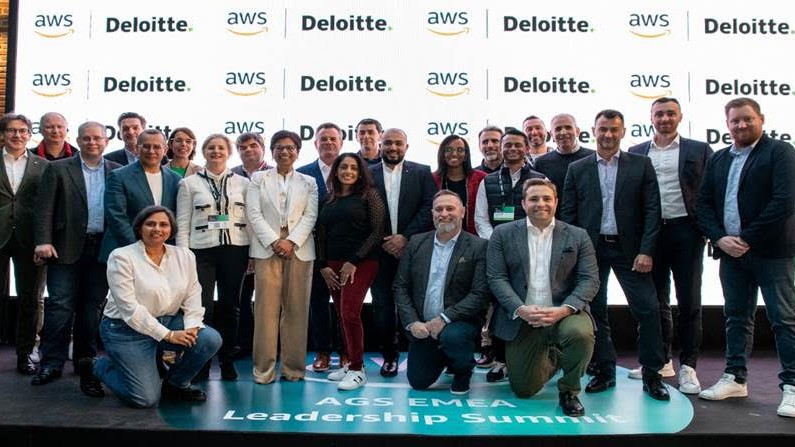In Silicon Valley, You Can Be Worth Billions and It’s Not Enough
In Silicon Valley, You Can Be Worth Billions and It’s Not Enough
Andreas Bechtolsheim, the first investor in Google, has an estimated $16 billion fortune. He recently settled charges that he engaged in insider trading for a profit of $415,726.
Category Archives: StartupWorld
Start-Up Founder Sentenced to 18 Months in Prison for Fraud
Start-Up Founder Sentenced to 18 Months in Prison for Fraud
Start-Up Founder Sentenced to 18 Months in Prison for Fraud
Manish Lachwani, who founded the software start-up HeadSpin, is the latest tech entrepreneur to face time in prison in recent years.
Cisco ramps up AI-era security with Hypershield
Cisco ramps up AI-era security with Hypershield
Cisco ramps up AI-era security with Hypershield


As the artificial intelligence revolution accelerates, the scale and complexity of data centres are straining conventional cybersecurity approaches. In response, Cisco Systems, the networking giant, unveiled a radical new AI-native security architecture called Hypershield on Wednesday.
“Hypershield is one of the most significant security innovations in our history,” said Chuck Robbins, Cisco’s chair and chief executive. “With our data advantage and strength in security, infrastructure and observability platforms, Cisco is uniquely positioned to help our customers harness the power of AI.”
The novel approach aims to secure applications, devices and data across public and private clouds as well as physical sites like factories and hospitals — anywhere organisations need protection in today’s decentralised computing landscape.
At its core, Hypershield reimagines security enforcement as a ubiquitous, self-managing fabric rather than a static perimeter. It can dynamically embed controls into software, virtual machines, servers, network switches and other hardware accelerators like Data Processing Units. This hyper-distributed model allows near-instantaneous threat detection and containment across an environment.
“When you have a distributed system that could include hundreds of thousands of enforcement points, simplified management is mission critical,” said Jeetu Patel, an executive vice president overseeing security at Cisco. “And we need to be orders-of-magnitude more autonomous, at an orders-of-magnitude lower cost.”
Three key pillars underpin Hypershield’s architecture: It is AI-native for autonomous operation, cloud-native via open-source eBPF technology, and hyper-distributed across hybrid infrastructure.
A major issue Hypershield tackles is vulnerability patching struggling to keep pace with escalating cyber threats. “Attackers are adept at weaponising newly published vulnerabilities faster than defenders can patch,” Mr. Patel said. Hypershield can test and deploy compensating controls in minutes, far outpacing traditional patching cycles.
Another critical capability is autonomous network segmentation. By perpetually observing traffic flows and reasoning over policies, Hypershield can dynamically divide networks to contain breaches and prevent lateral movement by hackers.
Hypershield also promises to streamline laborious software upgrade processes via digital twin testing and self-qualifying zero-downtime deployments.
“AI is not just a force for good but also a tool used for nefarious purposes,” said Frank Dickson, a vice president at analyst firm IDC. Hypershield’s ability to shield vulnerabilities almost instantly “is necessary to combat an increasingly clever malicious cyber adversary,” he added.
While audacious in scope, analysts lauded Cisco’s vision as fitting for AI-era security demands.
“The time is right given recent AI advances combined with the maturity of cloud-native technologies like eBPF,” said Zeus Kerravala, founder of ZK Research. Steven Aiello, a security executive at Cisco partner AHEAD, called Hypershield “a massive win for cyber-defenders.”
Underpinning Hypershield is Cisco’s unified Security Cloud platform augmented by recent acquisition Splunk for unrivalled visibility across customer environments. General availability is expected in August 2024.
As hyperscalers like Microsoft have already adopted similar architectural principles, Cisco — which protects all Fortune 100 companies — aims to deliver hyperscale-calibre security to the enterprise frontlines of the AI revolution.
Read next: Cisco Buys Splunk for $28 Billion, Betting Big on Data and Security
The post Cisco ramps up AI-era security with Hypershield appeared first on Ventureburn.
Deloitte and AWS Join Forces to Drive Cloud Adoption Globally
Deloitte and AWS Join Forces to Drive Cloud Adoption Globally
Deloitte and AWS Join Forces to Drive Cloud Adoption Globally


In a strategic move to accelerate cloud computing adoption across growth markets, Deloitte and Amazon Web Services (AWS) have entered into a multi-year Strategic Collaboration Agreement. This partnership brings together the globally No. 1-ranked professional services firm and the world’s most comprehensive and broadly adopted cloud to deliver large-scale transformations to customers while managing risk and driving real business change.
The expanded collaboration aims to help companies in all parts of the world to migrate their business operations to the cloud and prepare to compete in today’s digital economy. As Nishita Henry, Deloitte Global Chief Commercial Officer for AWS, said: “Moving to the cloud can be an intimidating undertaking that requires significant skills and resources. Through our expanded relationship with AWS, we are well-positioned to help our customers navigate this transition and maximise the business benefits of cloud computing in these growth markets.”
Expanding Workforce and Location Investments
As part of the first phase of this strategic collaboration, Deloitte will launch dedicated AWS Centers of Excellence in intentional locations worldwide, kicking off across Sub-Saharan Africa, Spain, and Central Europe. It plans to make a multimillion-dollar investment that includes hiring 800+ certified specialists and training practitioners on AWS services and capabilities.
A comprehensive suite of offerings will be made available to client organisations through this extended global network, providing customers with access to a broad range of AWS services from more than 56 offices in these initial regions. Multi-disciplinary AWS consulting teams, training academies, innovation labs, and managed services will help to empower local customers in their digital transformations.
“Through our global Strategic Collaboration, Deloitte and AWS will provide customers with the end-to-end guidance and services necessary to help overcome adoption barriers and successfully migrate to the cloud at scale,” said Jim Hudson, Managing Director and AWS Global Alliance Leader at Deloitte Consulting.
To help business leaders in these markets take advantage of growth opportunities, Deloitte will leverage its global innovation in data and artificial intelligence (AI). Deloitte’s data and AI practice combines the world-class services, AI talent, and deep industry experience that enterprise leaders need as they design generative AI strategies and create innovative AI applications.
Hundreds of businesses in Sub-Saharan Africa, Spain, and Central Europe are already benefitting from the combined expertise of AWS and Deloitte. As Natali Delić, Chief Strategy and Digital Officer of Telekom Srbija, said: “We are delighted by our dynamic collaboration with AWS and Deloitte, who are market leaders in accelerating cloud innovation. Working with them will ensure that our business transformation strategy includes the right technology to enable us to respond swiftly to our evolving needs, making significant impact and elevating the experiences of our customers and employees in all the markets where we operate.”
Addressing Industry Challenges
The extreme pace of business change and the rapid development in technologies such as generative AI, with recognised challenges like a lack of digital skills, make it difficult for many companies to plan and execute their business transformation. According to The future of jobs report 2023 by the World Economic Forum, organisations identify skills gaps (60% of respondents) and an inability to attract talent (53%) as the key barriers preventing industry transformation.
To support enterprise customers to overcome these multiple points of friction as they embark and expand their cloud journey, the Deloitte and AWS collaboration will leverage the power of a global system integrator, to help them transform at scale, innovate at speed, and, in the process, meet the complex needs of an ever changing landscape.
“We are very excited about this Strategic Collaboration Agreement to help even more global organisations take advantage of the agility, breadth of services, and pace of innovation that AWS provides,” said Dr. Ruba Borno, Vice President of AWS Worldwide Channels and Alliances. “Together with Deloitte, we will realise the promise of cloud computing across every region and industry.”
Enabling Business Transformation
In collaboration with AWS, Deloitte will help companies unlock the possibilities of cloud and digital transformation through key focus areas:
– Digital transformation: Supporting transformation of core processes, applications, and skills to achieve outcomes like agility, innovation, and cost optimisation in the cloud.
– Cloud strategy and governance: Helping define cloud visions, roadmaps, and governance models tailored to business objectives.
– Cloud architecture: Supporting cloud migrations by leveraging landing zones to establish foundational security, connectivity, and automation capabilities.
– Regulated industries: Providing specialised expertise in regulated domains like energy, ecommerce, insurance, banking, manufacturing, telecommunications, healthcare, and public sector to ensure compliance in the cloud.
– Global delivery network: Leveraging Deloitte’s ecosystem of 22+ Cloud Centers of Excellence, with 100,000 practitioners across strategy, operations, and technology, in combination with AWS Local Zones, to serve customers anywhere makes for a unique offering.
For Strini Mudaly, Vice President ICT at Gold Fields, one of the world’s largest gold mining firms, these focus areas were integral in shaping their successful modernisation initiative: “As we looked for a strategic partner to work with us in unlocking innovation through the cloud, Deloitte demonstrated both their AWS knowledge and understanding of our highly regulated industry. Through their collaborative approach using the AWS rich portfolio of services, we were able to modernise key systems and data platforms quickly while maintaining the highest security and compliance standards.”
Tanuja Randery, Managing Director for Europe, Middle East & Africa at AWS, said: “Kicking off our strategic collaboration across Europe, the Middle East, and Africa is testimony to the potential we see for cloud technology to transform business and drive economic growth within this region. We know from our own research with Strand Partners that in Europe cloud-enabled tech adoption could add €3.4 trillion to the economy by 2030.”
“In Africa, the appetite from businesses of all sizes to adopt cloud and AI is huge. If nurtured, its impact on the African economy will be transformative. We are proud of initiatives like the AWS Skills Center which helps build a cloud enabled workforce. Our partnership with Deloitte is another way to underscore our long term commitment and support for businesses in the region,” added Randery.
Read next: Cloud security myths that could be holding your small business back
The post Deloitte and AWS Join Forces to Drive Cloud Adoption Globally appeared first on Ventureburn.
Lisbon’s Hottest Tech Startups of 2024
Lisbon’s Hottest Tech Startups of 2024
Lisbon’s Hottest Tech Startups of 2024
The TechStartup scene in Lisbon is rapidly growing, with a dynamic and innovative tech industry that is a hub for TechTalent. The city is home to a myriad of exciting startups working in diverse domains such as #ArtificialIntelligence, #MachineLearning, #CyberSecurity, #DataScience and #SoftwareDevelopment. Lisbon’s tech ecosystem is extremely vibrant and offers a great TechLife. It’s […]
The post Lisbon’s Hottest Tech Startups of 2024 first appeared on TechMeetups.
Truth Social Has an Edge as Rival Right-Wing Apps Falter
Truth Social Has an Edge as Rival Right-Wing Apps Falter
Truth Social Has an Edge as Rival Right-Wing Apps Falter
Donald Trump’s social media platform has outdistanced similar conservative sites such as Parler and Gettr, even as it lags far behind X and others.
MFA Fatigue Attacks: The New Social Engineering Threat Plaguing Enterprises
MFA Fatigue Attacks: The New Social Engineering Threat Plaguing Enterprises
MFA Fatigue Attacks: The New Social Engineering Threat Plaguing Enterprises


While multifactor authentication (MFA) has long been heralded as an essential security measure for keeping corporate networks safe from cybercriminals, a new type of attack is exposing a critical vulnerability – human error.
Known as MFA fatigue or prompt spamming attacks, hackers are bombarding employees with an overwhelming number of login requests until they eventually accept one out of sheer frustration or confusion. This straightforward social engineering tactic exploits people’s psychological responses rather than relying on sophisticated hacking methods.
“MFA fatigue attacks exploit human vulnerability,” explains Anna Collard, SVP Content Strategy and Evangelist at KnowBe4 Africa, a cybersecurity training firm. “These attacks involve sending continuous push notifications to a target who has already provided their username and password, aiming to irritate or confuse them into unwittingly granting the attacker access.”
A high-profile example occurred in 2022 when hackers breached Uber’s IT systems this way. The attackers likely purchased an employee’s corporate login credentials on the dark web, then relentlessly spammed them with MFA requests. Claiming to be from Uber IT, the hackers convinced the exhausted employee that approving one request was the only way to stop the barrage of notifications.
“Now we’re seeing attackers finding ways around it by bombarding the victim with scores of MFA requests or by tricking them over the phone,” Collard says of MFA’s perceived impregnability. “By bugging you repeatedly until you give in, malicious actors can manipulate users into approving fraudulent access attempts.”
Preventing MFA Fatigue Compromise
To prevent such attacks, Collard recommends organisations avoid using push notifications for MFA entirely. “While MFA provides an extra layer of security, it’s not foolproof. From a cybersecurity perspective, I would recommend that organisations disable push notifications altogether and rather use alternative verification methods.”
Some better options include number matching, where users match a code from their authentication app to the one displayed during login, and challenge-response methods utilising biometrics like fingerprint or facial recognition. Organisations can also adopt open standards like FIDO2, which allows passwordless logins using hardware security keys.
However, Collard emphasises that no method is immune to skilled social engineering. Ultimately, “mindfulness is key” – users must stay calm and alert to anything that feels amiss, rather than reacting rashly under pressure.
As MFA fatigue attacks demonstrate, cybersecurity’s human element remains the most critical vulnerability. With hackers constantly adapting their tactics, enterprises must provide robust technology solutions and prioritise ongoing security awareness training to safeguard against both technical exploits and insidious psychological manipulation.
Read next: Cybercriminals exploit human error as biggest security flaw
The post MFA Fatigue Attacks: The New Social Engineering Threat Plaguing Enterprises appeared first on Ventureburn.
Talent agility: The missing piece in the business agility puzzle
Talent agility: The missing piece in the business agility puzzle
Talent agility: The missing piece in the business agility puzzle


Johann van Niekerk, Co-founder and CEO of Outsized, believes business leaders are overlooking a crucial component in their pursuit of agility – talent agility.
In turbulent and unpredictable markets, the ability to adapt swiftly is critical, and van Niekerk argues that talent agility enables businesses to pivot and respond adroitly to changing conditions. Rather than being constrained by rigid organisational structures, an agile talent model allows companies and their workforce to seamlessly realign, upskill, and fill gaps as needed.
“Rigid organisations, with fixed capabilities, find it very difficult to pivot or shift in periods of volatility,” says van Niekerk. “If a large corporation had enjoyed a few years of success in a growth market, it’s likely that they would have made plans to expand over the next three to five years, including hiring more people. But in the face of a sudden change, like a major economic downturn or a shift in the market which forces it to cut costs, redundancies will be almost unavoidable because it’s operating in a fixed-cost, fixed-capability model.”
The Solution: Talent-on-Demand
Van Niekerk advocates for a talent-on-demand strategy coupled with talent agility, which he believes offers clear benefits. “A more flexible organisation is able to break up work into project-based components that it can deliver quickly, while the market is still behaving the way it was when the project started,” he explains.
For instance, a department with a core team of 15 permanently employed individuals could bring in an additional 15 independent professionals during periods of heightened demand or project-based work. “In a variable-cost, flexible-capability model, the business recognises that it doesn’t need 30 people year-round and is able to reap the benefits of being more agile and more resilient to shocks,” van Niekerk notes.
Making It Work
While the concept seems straightforward, van Niekerk acknowledges that successfully implementing a talent agility strategy requires careful consideration of several key aspects:
1. Leadership Alignment: Businesses can approach talent-on-demand from either a business or HR perspective. Van Niekerk advocates for a hybrid approach that combines the speed and practicality of a business-led model with the detail-oriented, compliance-focused approach of an HR-led model.
2. Robust Onboarding: Ensuring a structured and well-designed onboarding process for independent consultants and contractors is critical. Legal, procurement, payroll, and compliance issues must be addressed upfront to mitigate risks and set up independent hires for success.
3. Pilot Testing: No talent model is perfect on paper. Van Niekerk recommends pilot testing on a small scale, learning from real-world experiences, and quickly applying those lessons before scaling up.
As more executives embrace agile talent models, van Niekerk believes businesses that successfully implement talent agility will be well-positioned to transform their growth and profitability trajectories.
Read next: How women could solve the technology industry’s talent drought
The post Talent agility: The missing piece in the business agility puzzle appeared first on Ventureburn.
Kit Vintage Is a Secondhand Oasis in Los Angeles
Kit Vintage Is a Secondhand Oasis in Los Angeles
Kit Vintage Is a Secondhand Oasis in Los Angeles
A laid-back shop in Los Angeles is a semi-secret spot for celebrities and costume designers.
Should You Use an Anti-Wrinkle Straw?
Should You Use an Anti-Wrinkle Straw?
Should You Use an Anti-Wrinkle Straw?
Another solution to a problem we didn’t know we had.
